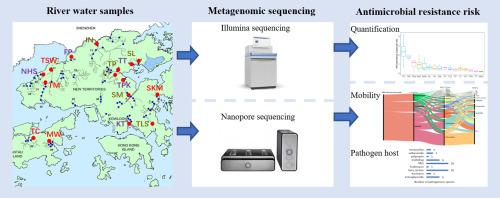Longitudinal metagenomic analysis on antibiotic resistome, mobilome, and microbiome of river ecosystems in a sub-tropical metropolitan city
IF 11.4
1区 环境科学与生态学
Q1 ENGINEERING, ENVIRONMENTAL
引用次数: 0
Abstract
Rivers play an important role as reservoirs and sinks for antibiotic resistance genes (ARGs). However, it remains underexplored for the resistome and associated mobilome in river ecosystems, and hosts of riverine ARGs particularly the pathogenic ones are rarely studied. This study for the first time conducted a longitudinal metagenomic analysis to unveil the resistome, mobilome, and microbiome in river water, by collecting samples from 16 rivers in Hong Kong over a three-year period and using both short-read and long-read sequencing. Results revealed that aminoglycoside, bacitracin, β-lactam, macrolide lincosamide-streptogramin, and sulfonamide were the predominant ARG types in the river water samples. Riverine ARGs exhibited high spatial variations in abundance and diversity. Environmental factors such as fecal coliform count, Escherichia coli count, 5-day biochemical oxygen demand (BOD5), dissolved oxygen (DO), and total organic carbon (TOC) had a significant correlation to the absolute concentrations of ARGs. Nanopore sequencing was used to reveal the physical genetic linkage of mobile genetic elements (MGEs) with ARGs in river water samples. The results showed that qacEdelta, transposase, integrase, and Tn916 had a high prevalence in ARG-carrying long reads. Host tracking using ARG-carrying reads identified 23 pathogenic bacteria species that harbored ARGs. Some ARGs were shared by different bacterial groups. This study presented a nuanced insight of resistome in river water by a longitudinal metagenomic analysis and deepened our understanding of common and divergent riverine antimicrobial resistant risk across the regional patterns.


亚热带大都市河流生态系统抗生素耐药组、移动组和微生物组的纵向宏基因组分析
河流作为抗生素耐药基因(ARGs)的储存库和汇库发挥着重要作用。然而,对河流生态系统中抵抗组和相关移动组的研究尚不充分,对河流ARGs宿主特别是致病性ARGs的研究很少。本研究首次进行了纵向宏基因组分析,通过收集香港16条河流的样本,在三年的时间里,使用短读和长读测序,揭示了河水中的抵抗组、移动组和微生物组。结果显示,氨基糖苷类、杆菌肽类、β-内酰胺类、大环内酯-链霉素类和磺胺类是主要的ARG类型。河流ARGs的丰度和多样性具有较大的空间差异。粪便大肠菌群数量、大肠杆菌数量、5 d生化需氧量(BOD5)、溶解氧(DO)、总有机碳(TOC)等环境因子与ARGs绝对浓度呈显著相关。利用纳米孔测序技术揭示了河流水样中移动遗传元件(MGEs)与ARGs的物理遗传联系。结果显示,qacEdelta、转座酶、整合酶和Tn916在携带arg的长reads中具有较高的流行率。利用携带arg的reads对宿主进行跟踪,鉴定出23种携带arg的致病菌。一些ARGs是由不同的细菌群共享的。本研究通过纵向宏基因组分析提供了对河水中抗菌素组的细致洞察,加深了我们对跨区域模式的常见和不同河流抗菌素耐药性风险的理解。
本文章由计算机程序翻译,如有差异,请以英文原文为准。
求助全文
约1分钟内获得全文
求助全文
来源期刊

Water Research
环境科学-工程:环境
CiteScore
20.80
自引率
9.40%
发文量
1307
审稿时长
38 days
期刊介绍:
Water Research, along with its open access companion journal Water Research X, serves as a platform for publishing original research papers covering various aspects of the science and technology related to the anthropogenic water cycle, water quality, and its management worldwide. The audience targeted by the journal comprises biologists, chemical engineers, chemists, civil engineers, environmental engineers, limnologists, and microbiologists. The scope of the journal include:
•Treatment processes for water and wastewaters (municipal, agricultural, industrial, and on-site treatment), including resource recovery and residuals management;
•Urban hydrology including sewer systems, stormwater management, and green infrastructure;
•Drinking water treatment and distribution;
•Potable and non-potable water reuse;
•Sanitation, public health, and risk assessment;
•Anaerobic digestion, solid and hazardous waste management, including source characterization and the effects and control of leachates and gaseous emissions;
•Contaminants (chemical, microbial, anthropogenic particles such as nanoparticles or microplastics) and related water quality sensing, monitoring, fate, and assessment;
•Anthropogenic impacts on inland, tidal, coastal and urban waters, focusing on surface and ground waters, and point and non-point sources of pollution;
•Environmental restoration, linked to surface water, groundwater and groundwater remediation;
•Analysis of the interfaces between sediments and water, and between water and atmosphere, focusing specifically on anthropogenic impacts;
•Mathematical modelling, systems analysis, machine learning, and beneficial use of big data related to the anthropogenic water cycle;
•Socio-economic, policy, and regulations studies.
 求助内容:
求助内容: 应助结果提醒方式:
应助结果提醒方式:


